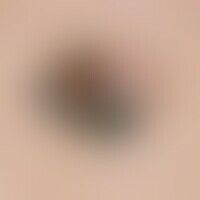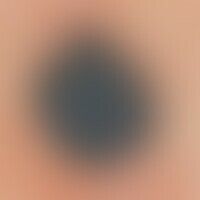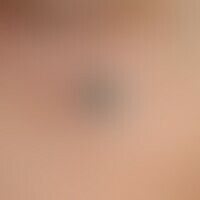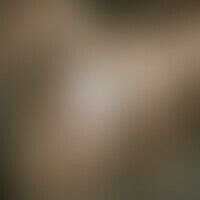Image diagnoses for "black"
81 results with 226 images
Results forblack

Melanoma nodular C43.L
Melanoma malignant nodular. reflected light microscopy from the peripheral area of the node. homogeneous blue-grey-black discoloration in the centre. radial streaming.

Melanoma nodular C43.L
melanoma, malignant, nodular. malignant melanoma of the primary-nodular type (detailed picture). in the last months surface and thickness growth. asymmetrical, irregular and blurredly limited, clearly raised, dark brown-black nodule of medium-rough consistency. crustal deposits.

Subungual melanoma C43.L
Melanoma malignes subunguales: Nail with stripy and periungual brown markings (Hutchinson's sign) in acrolentiginous malignant melanoma under the nail plate and in the nail bed (see Levit's ABC Rule)

Melanoma superficial spreading C43.L

Melanoma superficial spreading C43.L

Melanoma superficial spreading C43.L

Melanoma superficial spreading C43.L
Melanoma, malignant, superficially spreading: Exceptionally large, 8.0x4.0 cm in diameter, regressive, completely asymptomatic malignant melanoma of the SSM type. No bleeding, no oozing. The late visit to the doctor was inexplicable after about 20 years (photo comparisons possible) of growth. The patient carefully clothed the melanoma-bearing area during free exposure to the sun. See: Pigmentation of the central back areasstill slightly tanned after sun exposure.

Melanoma superficial spreading C43.L
Melanoma, malignant, superficially spreading.superficially spreading malignant melanoma with multiple, partly inconspicuous, partly dysplastic melanocytic nevi. over decades, regular, intensive sun exposure in southern European countries ("he just loves the sun").

Blue nevus D22.-
blue naevus. blue-black, coarse, sharply defined, calotte-shaped nodule with a smooth surface. at higher magnification some horn inclusions can be seen on the surface. in addition, hairs run through the nodule. especially the detection of hairs in the nodule area speaks against malignancy (DD: nodular malignant melanoma).

Blue nevus D22.-

Blue nevus D22.-

Blue nevus D22.-

Nevus sebaceus Q82.5
sebaceous nevus: Development of different tumor formations in a sebaceous nevus in a 45-year-old patient. In addition to a skin-colored, very rough area with a large basal cell carcinoma, formation of a solid hidradenoma (pigmented tumor on the lower left side). For therapy, the entire hamartoma was excised with a safety margin of 0.5 cm.

Onychomycosis (overview) B35.1
Tinea unguium. on the left thumb of a 28-year-old man localized yellow-brown to black dyschromas of the distal nail plate, increasing for more than one year. onychodystrophy beginning distally. mycologically a mixed infection of Trichophyton rubrum and Aspergillus spp. was detected.

Onychomycosis (overview) B35.1
Tinea unguium. dystrophic onychomycosis. colorful, not painful nail discoloration (yellow-blue-green) with nail thickening. part of the nail discoloration is apparently caused by bleeding. Tr. rubrum and molds (Alternaria spp.) have been detected culturally.

Onychomycosis (overview) B35.1
Tinea unguium. brown-yellow striped lateral nail dystrophy on the index and ring finger. cultural evidence of Trichophyton rubrum and mould species.

Onychomycosis (overview) B35.1
Tinea unguium with extensive, older traumatic bleeding into the nail matrix.

Onychomycosis (overview) B35.1
Tinea unguium. distal onychomycosis with crumbly destruction of the nail matrix. aphlegmatic tinea of the toe skin with low lichenification and pityriasiform scaling.

Incineration T30.0
Burns: severe fourth-degree burns on the buttocks of a 23-year-old woman after gynaecological surgery with electrocautery application with incorrectly attached neutral electrode and moist pad.

Vitiligo (overview) L80

Fixed drug eruption L27.1
Drug reaction, fixed: unusual image of a 3.5 x 2.5 cm measuring, crusty covered, flat ulcer on the lower leg of a 38-year-old patient as a result of repeated use of non-steroidal anti-inflammatory drugs; the reddish discolored periulcerous area and the blue-violet discoloration of the necroses result from the topical application of methylrosanilinium chloride during external therapy.



